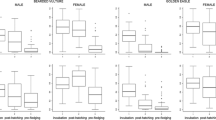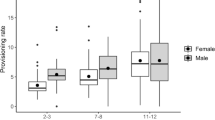Abstract
Parental investment varies in mammalian species, with male care of young being more common in social and monogamous species. Monogamy is commonly observed in canid species, with both males and females, and often “helper” individuals, providing some degree of care for the young. Social units of the swift fox (Vulpes velox), a small North American canid species, usually consist of a male–female pair and occasionally helpers. The role of parental investment and behavior in swift fox society is currently poorly understood. We observed swift fox dens during the pup-rearing season in each of 2 years to evaluate attendance and frequency of visits to natal dens by adult males and females. Female foxes remained at dens longer and visited them more frequently than did male foxes. Female attendance and visitation decreased throughout the pup-rearing season as pups became older and more independent. Environmental factors, including climate and its effect on prey, appeared to contribute to differences in fox behavior between the 2 years. We observed only one fox outside of the breeding pair attending a den in each of the 2 years, both of which were males. We concluded that each of these two foxes were living within the social unit of the male–female pair as a trio, but not serving as a helper and contributing to the care of the pups. Our results increased knowledge of the ecology and behavior of the swift fox, a species of conservation concern in the Great Plains of North America.




Similar content being viewed by others
References
Bekoff M (1977) Canis latrans. Mamm Species 79:1–9
Branson DH (2008) Influence of a large late summer precipitation event on food limitation and grasshopper population dynamics in a northern Great Plains grassland. Environ Entomol 37:686–695
Capinera JL, Horton DR (1989) Geographic variation in effects of weather on grasshopper infestation. Environ Entomol 18:8–14
Clutton-Brock TH (1991) The evolution of parental care. Princeton University Press, Princeton
Covell DF (1992) Ecology of the swift fox (Vulpes velox) in southeastern Colorado. MS thesis, University of Wisconsin, Madison
de Melo LFB, Sábato MAL, Magni EMV, Young RJ, Coelho CM (2009) First observations of nest attendance behavior by wild maned wolves, Chrysocyon brachyurus. Zoo Biol 28:69–74
Egoscue HJ (1979) Vulpes velox. Mamm Species 122:1–5
Garrott RA, Eberhardt LE, Hanson WC (1984) Arctic fox denning behavior in northern Alaska. Can J Zool 62:1636–1640
Geffen E, Gompper ME, Gittleman JL, Luh H, Macdonald DW, Wayne RK (1996) Size, life-history traits, and social organization in the Canidae: a reevaluation. Am Nat 147:140–160
Geffen E, Macdonald DW (1992) Small size and monogamy: spatial organization of Blanford’s foxes, Vulpes cana. Anim Behav 44:1123–1130
Gusset M, Macdonald DW (2010) Group size effects in cooperatively breeding African wild dogs. Anim Behav 79:425–428
Hatier KG (1995) Effects of helping behaviors on coyote packs in Yellowstone National Park, Wyoming. MS thesis, Montana State University, Bozeman
Kamler JF, Ballard WB, Gese EM, Harrison RL, Karki S, Mote K (2004) Adult male emigration and a female-based social organization in swift foxes, Vulpes velox. Anim Behav 67:699–702
Karki SM, Gese EM, Klavetter ML (2007) Effects of coyote population reduction on swift fox demographics in southeastern Colorado. J Wildl Manag 71:2707–2718
Kilgore DL Jr (1969) An ecological study of the swift fox (Vulpes velox) in the Oklahoma panhandle. Am Midl Nat 81:512–534
Kitchen AM, Gese EM, Schauster ER (1999) Resource partitioning between coyotes and swift foxes: space, time, and diet. Can J Zool 77:1645–1656
Kitchen AM, Gese EM, Karki SM, Schauster ER (2005a) Spatial ecology of swift fox social groups: from group formation to mate loss. J Mammal 86:547–554
Kitchen AM, Gese EM, Waits LP, Karki SM, Schauster ER (2005b) Genetic and spatial structure within a swift fox population. J Anim Ecol 74:1173–1181
Kitchen AM, Gese EM, Waits LP, Karki SM, Schauster ER (2006) Multiple breeding strategies in the swift fox, Vulpes velox. Anim Behav 71:1029–1038
Kleiman DG (1977) Monogamy in mammals. Q Rev Biol 52:39–69
Kleiman DG, Malcolm JR (1981) The evolution of male parental investment in mammals. In: Gubernick DJ, Klopfer PH (eds) Parental care in mammals. Plenum, New York, pp 347–387
Kozlowski AJ, Bennett TJ, Gese EM, Arjo WM (2003) Live capture of denning mammals using an improved box trap enclosure: kit foxes as a test case. Wildl Soc Bull 31:630–633
Macdonald DW (1979) ‘Helpers’ in fox society. Nature 282:69–71
Macdonald DW, Creel S, Mills MGL (2004) Society: canid society. In: Macdonald DW, Sillero-Zubiri C (eds) The biology and conservation of wild canids. Oxford University Press, Oxford, pp 85–106
Mech LD (1970) The wolf: the ecology and behavior of an endangered species. University of Minnesota Press, Minneapolis
Moehlman PD (1979) Jackal helpers and pup survival. Nature 277:382–383
Moehlman PD (1986) Ecology of cooperation in canids. In: Rubenstein DI, Wrangham R (eds) Ecological aspects of social evolution. Princeton University Press, Princeton, pp 64–86
Nicholson WS, Hill EP, Briggs D (1985) Denning, pup-rearing, and dispersal in the gray fox in east-central Alabama. J Wildl Manag 49:33–37
Olson TL, Lindzey FG (2002) Swift fox survival and production in southeastern Wyoming. J Mammal 83:199–206
Pechacek P (2000) Activity radii and intraspecific interactions in the swift fox (Vulpes velox). Biologia (Bratislava) 55:201–205
Ralls K, Pilgrim KL, White PJ, Paxinos EE, Schwartz MK, Fleischer RC (2001) Kinship, social relationships, and den sharing in kit foxes. J Mammal 82:858–866
Ribble DO, Samson FB (1987) Microhabitat associations of small mammals in southeastern Colorado, with special emphasis on Peromyscus (Rodentia). Southwest Nat 32:291–303
Rongstad OJ, Laurion TR, Andersen DE (1989) Ecology of swift fox on the Pinon Canyon Maneuver Site, Colorado. Final report to the U.S. Army, Fort Carson. Wisconsin Cooperative Wildlife Research Unit, University of Wisconsin, Madison
SAS Institute (2011) SAS/STAT user’s guide. Release 9.3. SAS Institute, Cary.
Schauster ER, Gese EM, Kitchen AM (2002a) Population ecology of swift foxes (Vulpes velox) in southeastern Colorado. Can J Zool 80:307–319
Schauster ER, Gese EM, Kitchen AM (2002b) An evaluation of survey methods for monitoring swift fox abundance. Wildl Soc Bull 30:464–477
Shaw RB, Anderson SL, Schulz KA, Diersing VE (1989) Plant communities, ecological checklist, and species list for the U.S. Army Piñon Canyon Maneuver Site, Colorado. Colorado State University, Department of Range Science, Science Series No. 37, Fort Collins
Storm GL, Andrews RD, Phillips RL, Bishop RA, Siniff DB, Tester JR (1976) Morphology, reproduction, dispersal, and mortality of midwestern red fox populations. Wildl Monogr 49:3–82
Strand O, Landa A, Linnell JDC, Zimmermann B, Skogland T (2000) Social organization and parental behavior in the arctic fox. J Mammal 81:223–233
Thompson CM, Gese EM (2007) Food webs and intraguild predation: community interactions of a native mesocarnivore. Ecology 88:334–346
United States Geological Survey (2012) National water information system. http://waterdata.usgs.gov/co/nwis/inventory/?site_no=372319104073301 and http://waterdata.usgs.gov/co/nwis/inventory?site_no=373004104032001. Accessed 13 February 2012
Vergara V (2001) Comparison of parental roles in male and female red foxes, Vulpes vulpes, in southern Ontario. Can Field Nat 115:22–33
von Schantz T (1984) ‘Non-breeders’ in the red fox Vulpes vulpes: a case of resource surplus. Oikos 42:59–65
Wright HWY (2006) Paternal den attendance is the best predictor of offspring survival in the socially monogamous bat-eared fox. Anim Behav 71:503–510
Acknowledgments
Funding and logistical support was provided by the U.S. Army, Directorate of Environmental Compliance and Management, Fort Carson, Colorado, through the U.S. Fish and Wildlife Service, Colorado Assistance Office, Denver, Colorado. Additional support was provided by the U.S. Department of Agriculture, Wildlife Services, National Wildlife Research Center at Utah State University, Logan, Utah. We thank E. Joyce, C. Thompson, J. White, E. Cleere, M. Watkins, D. Degeranno, A. Larkins, C. Roemer, D. Fletcher, W. Ulrey, S. Schopman, C. Gazal, A. Knipps, J. Garner, and C. Briggs for field assistance. We also thank S. Durham for statistical assistance.
Author information
Authors and Affiliations
Corresponding author
About this article
Cite this article
Poessel, S.A., Gese, E.M. Den attendance patterns in swift foxes during pup rearing: varying degrees of parental investment within the breeding pair. J Ethol 31, 193–201 (2013). https://doi.org/10.1007/s10164-013-0368-y
Received:
Accepted:
Published:
Issue Date:
DOI: https://doi.org/10.1007/s10164-013-0368-y




